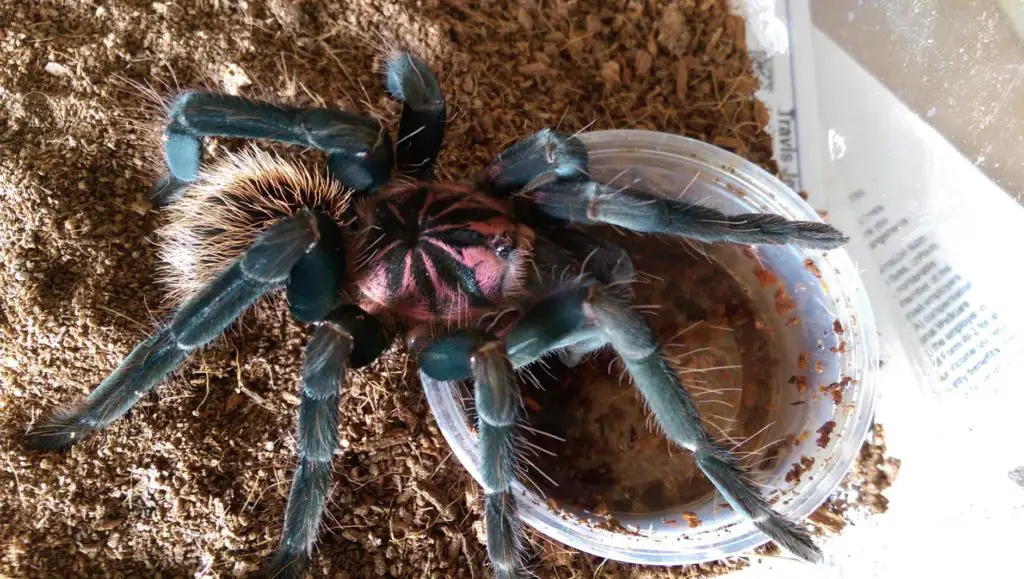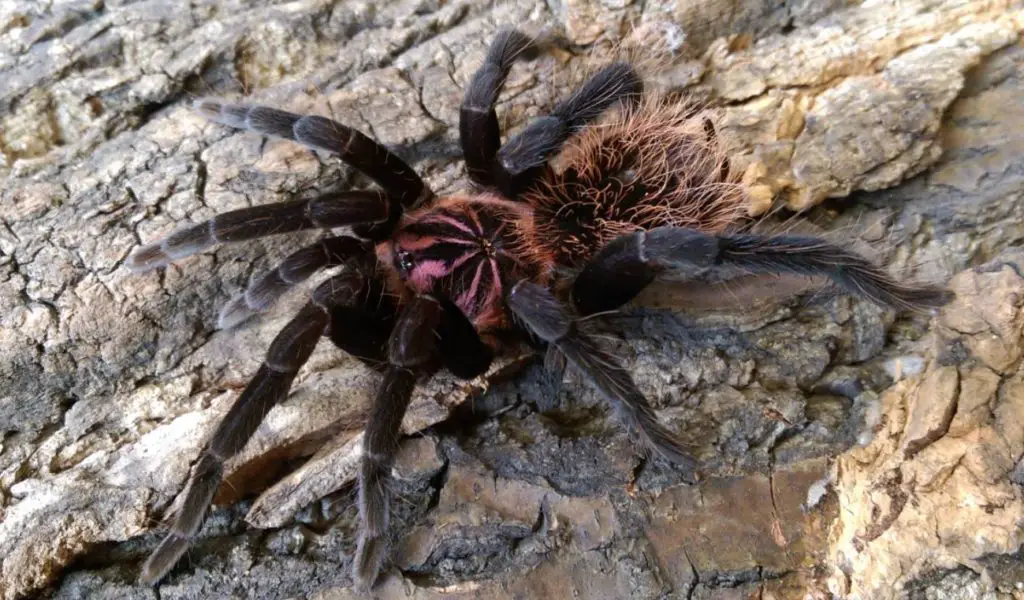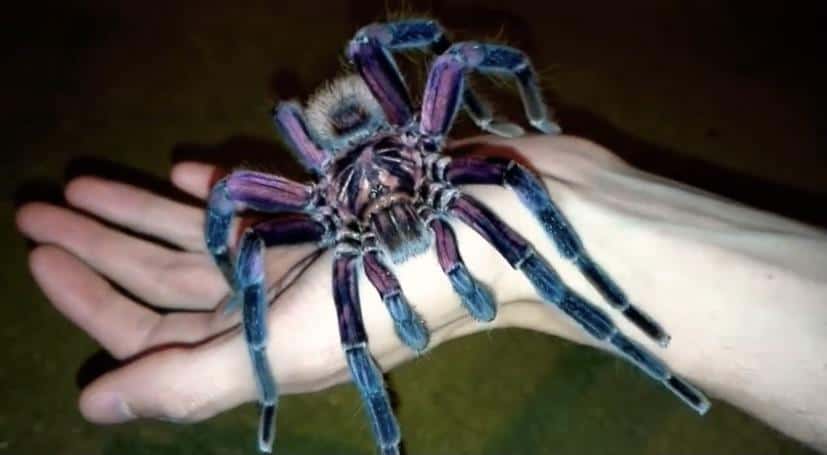The Amazon Blue Bloom Tarantula (Xenesthis Intermedia) is a New World Species that lives exclusively in Venezuela. Known as one of the larger tarantulas, she’s considered exotic even among veteran collectors.
Due to her nervous behavior and high market price, it’s not recommended as a tarantula for beginners. If, however, you’re still captivated by its beauty, here’s everything that you need to know about this stunning species.

| Species Name | Xenesthis Intermedia |
| Family Name | Theraphosidae |
| Common Names | Amazon Blue Bloom Tarantula |
| Category | New World |
| Type | Terrestrial Opportunistic Burrower |
| Native Location | Venezuela |
| Body length | 2.5 inches (~7 cm) |
| Leg Span | 8 inches (~21 cm) |
| Growth Speed | Fast |
| Urticating Hairs | Yes |
| Social | Solitary |
| Diet | Insects: primarily crickets and roaches |
| Temperature | 73°F – 80°F (day), 66°F – 71°F (night) |
| Humidity | 70% to 75% |
| Lifespan | Female: 12 to 15 years / Male: 3 to 4 years |
| Experience required | Intermediate |
| Minimum tank size | 10 gallons |
Amazon Blue Bloom tarantula Overview
The Xenesthis Intermedia, nicknamed in the hobby as Amazon Blue Bloom Tarantula (ABBT) or Venezuelan Blue Bloom Tarantula, is a terrestrial opportunistic burrower.
The Amazon Blue Bloom is a New World species, and as such, she can flick urticating hairs when she’s threatened. She was described pretty recently, so information about her is scarce.
However, new research results are expected to come out around this year (2022).
Commonly mistaken with her Colombian cousin, the Xenesthis Inmanis, this spider exhibits a pink/purple coloration that often covers most of her body. This trait differentiates her from her fellow Xenesthis relatives.
Appearance and Variants

The Amazon Blue Bloom Tarantula is a pretty particular and attractive spider. Her vast size and colorful patterns make her appealing to hobbyists. They grow to a size of up to 8 inches as adults.
As a spiderling, she mostly displays brown and dark colors. Once she matures, her frontal femurs show an eccentric pink/purple color that goes from her proximal half to her cephalothorax.
She exhibits a striped pattern in the cephalothorax, which turns blueish depending on the light’s angle in some specimens. Her abdomen will instead show a light-brown coloration.
The Amazon Blue Bloom’s body is covered with light-colored urticating hairs, which give her a coated look when they’re grown.
These spiders exhibit sexual dimorphism. Females are slightly bigger with darker patterns in their cephalothorax rather than purple. The male will usually display the bright pink and purple colors described above. In addition, as is standard in arachnids, males are smaller than females.
Price
The Amazon Blue Bloom Tarantula is exotic and new to the hobby. An unsexed specimen or an adult male will round the $100 mark.
Meanwhile, adult females can sell for as much as $275 in some cases.
Behavior and Temperament
The Amazon Blue Bloom Tarantula is known for being a really shy and nervous spider. She will run in most cases when threatened.
However, she tends to flick her urticating hairs as she retreats, so caution is advised when handling her, as these hairs can do quite a bit of damage if they end up in your eyes, nose, or mouth.
She has a characteristic threat posture when she’s cornered. She raises her abdomen for a while before biting her aggressor, but only in extreme circumstances.
The Amazon Blue Bloom Tarantula prefers flight over fight, so it’s unlikely that you’re going to get bitten. Since this is a newly discovered species, not much is known about the potency of their venom, but most New World species have very mild venom.
Caring for an Amazon Blue Bloom Tarantula

Temperature and Humidity
The Amazon Blue Bloom Tarantula lives in tropical lowland rain forests with temperatures around 80°F. It’s a high humidity environment of around 75% – 80%.
She tends to go deeper into her burrow when the temperature rises, searching for a cooler and humid environment.
Keep your tank at around 73°F – 80°F (day) and 66°F – 71°F (night), with humidity around 70% to 75% to keep your spider comfortable.
Substrate
Amazon Blue Bloom Tarantulas are terrestrial and opportunistic burrowers, which means they need enough substrate to burrow. Spiderlings should get at least three inches of substrate; however, both juveniles and adults should have five inches as a minimum.
They’re large spiders, so even if they don’t burrow too deep, they still need enough room to descend when it’s hot. The substrate composition should include soft and moisture-retaining materials such as peat moss, coconut fiber, and vermiculite.
Tank
The Amazon Blue Bloom is a very large spider, so it needs enough space to be comfortable. Also, make sure the distance between the substrate and the tank’s ceiling isn’t too long. Large terrestrial spiders can injure themselves badly if they fall from a high place, so it’s better to have a longer and wider tank than it is tall and to fill it with plenty of substrate.
Adult Amazon Blue Bloom Tarantulas should be kept in tanks that are big enough to accommodate their large size so make sure that their tank is at least 10 gallons with more horizontal than vertical space.
As opportunistic burrowers, they’re most comfortable (and less prone to attacking) when they have plenty of hiding places. Therefore, you should add a piece of cork bark and a couple of fake plants as decoration.
Watering
Amazon Blue Bloom Tarantulas are used to humid environments, so make sure to spray the substrate regularly.
Also, maintain a water dish inside the tank and refill it every time it’s empty to keep the tarantula hydrated.
Diet and Feeding
As her size suggests, Amazon Blue Bloom Tarantula has a voracious appetite. Plenty of hobbyists will enjoy watching her eat. She will thrive on a diet that consists of insects.
Spiderlings could be fed a flightless fruit fly or a small cricket twice a week. A Juvenile specimen should get around three to four small crickets weekly.
Adult specimens have a bigger appetite, so one large B. dubia roach or seven large crickets every week would be enough to feed them.
There’s not all that much information about these spiders yet, so make sure to adjust her diet if you see her abdomen grow too big or start shrinking.
You have to decrease or increase the frequency or food portions to make sure she’s not overfed or starving.
Amazon Blue Bloom Tarantula Facts
- She’s typically confused with Xenenthis immanis.
- There’s little knowledge about the Xenesthis genus since only three out of the six known species have been described: Xenesthis monstrosa, Xenenthis immanis, and Xenesthis intermedia.
- The Amazon Blue Bloom is mostly seen with a slight degree of alopecia (baldness) over the abdomen. This is most likely because of her tendency to flick urticating hairs.
- It’s considered one of the most exotic and expensive tarantulas on the market. When she was described for the first time, her market price rose to over $500.
Final words
It’s always exciting to work with new tarantulas. Being part of the first pioneers that’ll discover the habits of a new beautiful species may be the push you were looking for to get one of these beautiful spiders.
They might not be very suitable for beginners, but if you’ve built up some experience and want to try your hand at caring for a lesser-known species that exhibits some very beautiful colors, then the Amazon Blue Bloom could be a great choice!
- How Long Do American Eskimo Dogs Live? Important Factors and Care Tips - September 29, 2023
- Do American Bulldogs Need Grooming? Essential Tips and Care Guidelines - September 29, 2023
- Do Bengal Cats Enjoy Playing? Essential Tips for Keeping Them Active - September 29, 2023